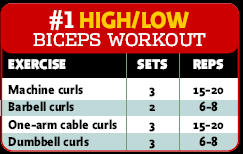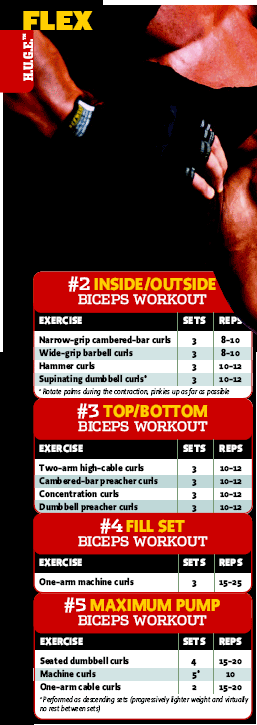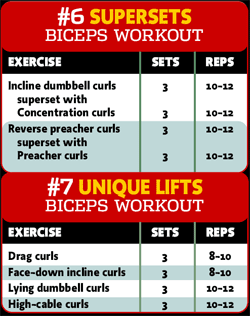28-Days-to-Lean Meal Plan
With the right plan and the right discipline, you can get seriously shredded in just 28 days.
Read article
Do we really need to sell biceps training to a reader of the leading bodybuilding magazine? Of course you want bigger arms. Of course you've already done more curling than an octogenarian hairdresser. We assumed those facts before you arrived here in the hardgainer department. So, without further ado, here are seven fresh approaches to biceps training to help you bi-pass the no-growth rut of the same old curls performed the same old way.
#1 | HIGH/LOW
People tend to do virtually the same number of reps in all sets for a bodypart. If they do both high and low reps, they will typically segregatethose sets into a "light" day and a "heavy" day. But why not do them on the same day? Alternating sets or exercises for high reps (12-20) with those done for low reps (six to eight) is an excellent way of targeting fastand slow-twitch fibers and increasing both blood volume and strength. Starting with a high-rep machine exercise, as in the sample routine provided here, allows you to safely warm up for the heavy free weights that follow.

#2 | INSIDE/OUTSIDE
The biceps muscle comprises a long head (outer biceps) and a short head (inner biceps) and both have different tendon connections. The two heads work together, so you can't fully isolate your inner or outer biceps. However, if you take a narrow grip and/or angle your palms so your index fingers are above your other fingers, you will focus more on the outer heads (as well as the brachialis, which is visible on your outer arms). Conversely, if you take a wide grip and/or angle your palms so your pinkies are at least even with your other fingers, you will focus more on the inner heads.
#3 | TOP/BOTTOM
Just as you cannot truly isolate the inner and outer heads, you can't work only the bottom or top portions of your biceps. However, you can focus more on the stretch or the contraction. Preacher curls place greater emphasis on the stretch, and concentration or high-cable curls tend to place greater emphasis on the contraction.

#4 | FILL ER UP IFBB
pro Chris Cook does what he calls "fill sets" to flush blood into his arms on days between regular arm workouts. These consist of three or four highrep (15-25) sets of an isolation exercise, done after training another bodypart. For bis, he typically does concentration curls, one-arm machine curls or hammer curls. Cook believes that fill sets aid recovery and boost blood volume and were key to his arm growth in recent years. Perform a fill set workout at least two days after and two days before your regular biceps workout.
For more press NEXT–>
#5 | HIGHER UP A maximum biceps pump is among the most satisfying feelings you can experience in a gym, and many trainers find that their arms respond especially well to blood-volumizing workouts. The best way to pump up the blood is with higher reps; intensifying techniques, such as drop sets; and a rapid pace (less than 45 seconds between sets). As prescribed in "The Big Pump", you may also want to increase your carbohydrates before workouts and use supplements, including arginine, creatine and citrulline.
#6|SUPERSETS Many people consider the biceps too small a muscle to perform superset exercises for it alone. The common practice is to superset bis with tris instead. We do recommend biceps/triceps antagonistic supersets. More advanced bodybuilders, however, shouldn't shy away from occasionally combining biceps exercises. Intensity is your friend, not your enemy. The original King of the Biceps, 1965-66 Mr. Olympia Larry Scott, frequently performed biceps supersets and trisets.

#7 | UNIQUE LIFTS Your biceps have relatively simple functions: to contract your elbow joints (bring your hands toward your shoulders) and supinate your forearms (rotate your forearms from palms down to palms up). Therefore, you may think it doesn't make much difference which curls you do each workout. In fact, each exercise works your bis in subtly different ways, some stressing more of the inner head, some more of the outer, some focusing more on the contraction, others more on the stretch. Make variety a key component of your workouts. If your gym has multiple curl machines, try each of them. The biceps exercises listed here are rarely performed, but they can be done in almost any gym. Incorporate one into your current routine or try our workout featuring all four.
Drag curls Let your elbows go backward and come up as you literally drag a barbell against your body from your upper legs to your lower chest. These can also be performed on a Smith machine, which locks you into a straight up-and-down motion. .Face-down incline curls Boyer Coe, known for his pointy bis, frequently did incline curls lying face-down on a bench. This method places a special emphasis on the contractions. Holding a pair of dumbbells, let your arms hang straight down; then, curl the dumbbells and supinate your forearms while keeping your elbows steady.
Lying dumbbell curls Lie faceup on a high flat bench (you may need to elevate the bench by placing blocks or weight plates under the legs). Let your arms hang straight down, then curl the dumbbells while keeping your elbows steady. You can do these with your forearms nearly parallel to the bench or to focus more on the inner heads of the biceps with your forearms out at 90-degree angles to the bench.
High-cable curls Begin with your arms outstretched, holding a stirrup handle attached to a high pulley in each hand, and then curl your hands to your delts as if performing a double-biceps pose. This provides both a unique stretch and a unique contraction.
# 8 BI-LAWS | These workouts wonÂt magically turn golf-ballsized biceps into the softball variety. However, with hard work, they can shock complacent muscles from stagnation to expansion. Biceps can and should be trained with a greater variety of exercises, techniques and combinations than most bodybuilders typically keep in their arsenals. With the advice offered here, you can now load up your own biceps routines and get a bigger bang for your training buck. FLEX